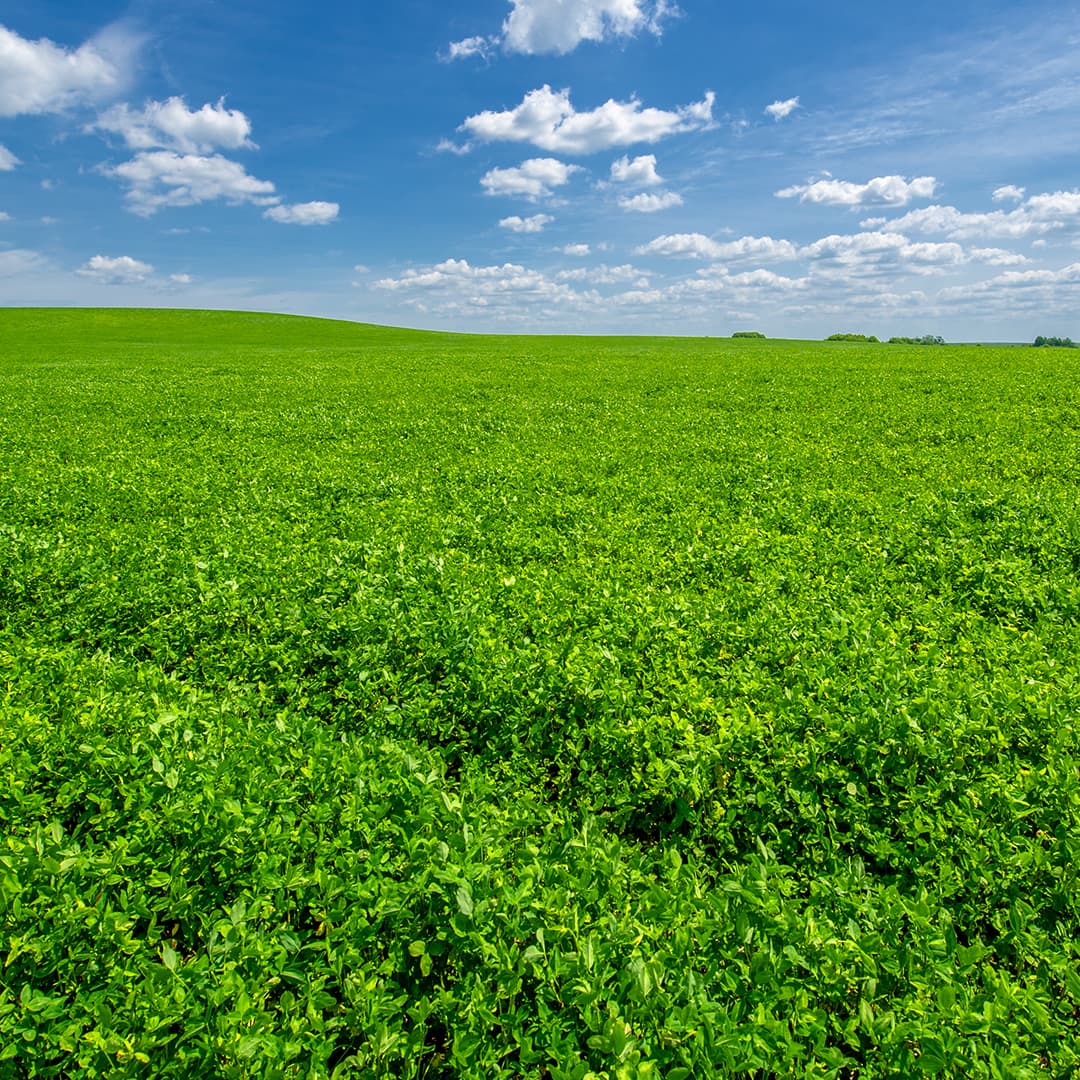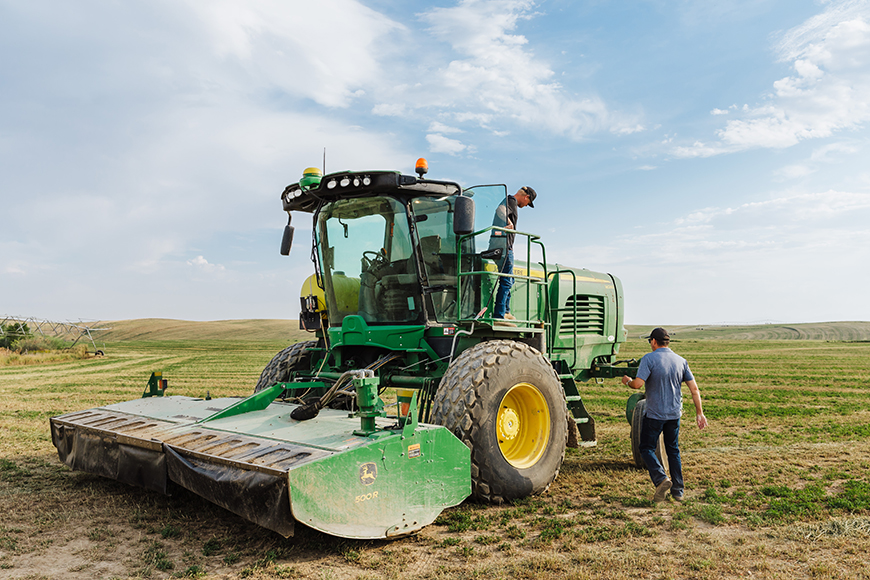Hard Seed Percentage in Alfalfa: How High is Too High?
Alfalfa seed with impermeable seed coats are called hard seeds because, when exposed to water, these seeds do not take up moisture but remain unchanged, or hard. When planted, these hard alfalfa seeds may remain dormant in the soil for a matter of days or even years. Hard seed percentages of 30-40% are common in northwestern U.S.–grown alfalfa seed, while seed produced in the southwestern U.S. commonly displays hard seed percentages in the 5-15% range. Unfortunately, little seed of winterhardy alfalfas is now produced in California due to rising production costs (water shortages, pesticide legislation, etc).
If given the opportunity, most alfalfa growers would prefer to purchase alfalfa seed with less than 10% hard seed. Unfortunately, the realities of wintehardy alfalfa seed production in North America will supply growers with alfalfa seed higher in hard seed percentage than they are comfortable with.
How can companies in winterhardy alfalfa seed production (e.g. W-L Research) keep hard seed percentages low? There are three basic ways to reduce hard seed percentage:
W-L Research, Evansville, WI— The effect of hard seed percentages on stand establishment (seedlings/ sq. ft.) at two seeding rates (10 and 18 lbs/acre) were evaluated at Evansville, WI. Several conclusions were made. First, seeding rate had the greatest impact on stand establishment. Even at 28% hard seed, the higher seeding rate (18 lbs/acre) produced an excellent stand (36 plants/ sq.ft.). Note that many agronomists consider 15 or more plants/sq. ft. at the end of the seeding year to represent good stand establishment. This was easily achieved at the typical seeding rate of 18 lbs/ac, regardless of hard seed percentage. Growers should not ignore hard seed percentages when purchasing alfalfa seed, but results from this study indicate that widely recommended seeding rates are capable of producing adequate first-year stands even at hard seed percentages as high as 28%.
University of Wisconsin—Dr. Ken Albrecht and colleagues established a three-location study to determine the effects of hard seed percentage on forage yields of new alfalfa seedings. Do hard seed levels affect subsequent alfalfa yields? They found that hard seed percentage had essentially no effect on yield in either the seeding year or the year after seeding. Even the high (45%) hard seed lots produced yields comparable to low (8%) hard seed lots. The conclusion reached by the University of Wisconsin researchers? Hard seed levels up to 40% had no impact on germination or yield of alfalfa.
Recommendations—How should growers deal with the issue of hard seed in alfalfa? First, if only a high hard seed percentage lot is available, you can fall back on higher seeding rates. Second, do not get overly concerned with hard seed percentages in the 10-20% range, especially if you are seeding at 15-18 lbs/ac into a clod-free, firm seedbed. Hard seed percentage within this range had absolutely no detrimental impact on stand establishment in the seeding year. If a high hard seed lot is encountered, a little more attention to seed bed preparation and seeding rate is all that’s needed to ensure good stand establishment. Finally, don’t let hard seed levels make your alfalfa variety decision for you. You’re much better off planting the best-adapted variety for your farm at a higher hard seed percentage than compromising on the alfalfa genetics just to get seed with a lower hard seed percentage.
Alfalfa seed with impermeable seed coats are called hard seeds because, when exposed to water, these seeds do not take up moisture but remain unchanged, or hard. When planted, these hard alfalfa seeds may remain dormant in the soil for a matter of days or even years. Hard seed percentages of 30-40% are common in northwestern U.S.–grown alfalfa seed, while seed produced in the southwestern U.S. commonly displays hard seed percentages in the 5-15% range. Unfortunately, little seed of winterhardy alfalfas is now produced in California due to rising production costs (water shortages, pesticide legislation, etc).
If given the opportunity, most alfalfa growers would prefer to purchase alfalfa seed with less than 10% hard seed. Unfortunately, the realities of wintehardy alfalfa seed production in North America will supply growers with alfalfa seed higher in hard seed percentage than they are comfortable with.
How can companies in winterhardy alfalfa seed production (e.g. W-L Research) keep hard seed percentages low? There are three basic ways to reduce hard seed percentage:
- Storage. Normal storage times from seed harvest to planting will reduce hard seed percentage, sometimes significantly. However, it is impossible to predict with any certainty whether hard seed percentage will decline in storage. In addition, storing alfalfa seed for two or more years to reduce hard seed may have other detrimental impacts on seedling vigor.
- Scarification is the mechanical abrasion of the seed coat and this procedure will reduce hard seed percentages but can also injure the seed. However, newer and better scarification techniques have reduced the downside (reduced seedling viability and vigor) to this process.
- Blending. The best available method for reducing hard seed percentages is blending. This procedure takes two or more seed lots of the same alfalfa variety that differ in hard seed percentage, and physically blends them together, thus creating a new lot of seed which has an acceptable (lower) level of hard seed. W-L Research is working hard to produce seed of each variety in several different locations, thus providing the inventory flexibility needed to conduct an effective blending (and hard seed reduction) program.
W-L Research, Evansville, WI— The effect of hard seed percentages on stand establishment (seedlings/ sq. ft.) at two seeding rates (10 and 18 lbs/acre) were evaluated at Evansville, WI. Several conclusions were made. First, seeding rate had the greatest impact on stand establishment. Even at 28% hard seed, the higher seeding rate (18 lbs/acre) produced an excellent stand (36 plants/ sq.ft.). Note that many agronomists consider 15 or more plants/sq. ft. at the end of the seeding year to represent good stand establishment. This was easily achieved at the typical seeding rate of 18 lbs/ac, regardless of hard seed percentage. Growers should not ignore hard seed percentages when purchasing alfalfa seed, but results from this study indicate that widely recommended seeding rates are capable of producing adequate first-year stands even at hard seed percentages as high as 28%.
University of Wisconsin—Dr. Ken Albrecht and colleagues established a three-location study to determine the effects of hard seed percentage on forage yields of new alfalfa seedings. Do hard seed levels affect subsequent alfalfa yields? They found that hard seed percentage had essentially no effect on yield in either the seeding year or the year after seeding. Even the high (45%) hard seed lots produced yields comparable to low (8%) hard seed lots. The conclusion reached by the University of Wisconsin researchers? Hard seed levels up to 40% had no impact on germination or yield of alfalfa.
Recommendations—How should growers deal with the issue of hard seed in alfalfa? First, if only a high hard seed percentage lot is available, you can fall back on higher seeding rates. Second, do not get overly concerned with hard seed percentages in the 10-20% range, especially if you are seeding at 15-18 lbs/ac into a clod-free, firm seedbed. Hard seed percentage within this range had absolutely no detrimental impact on stand establishment in the seeding year. If a high hard seed lot is encountered, a little more attention to seed bed preparation and seeding rate is all that’s needed to ensure good stand establishment. Finally, don’t let hard seed levels make your alfalfa variety decision for you. You’re much better off planting the best-adapted variety for your farm at a higher hard seed percentage than compromising on the alfalfa genetics just to get seed with a lower hard seed percentage.



